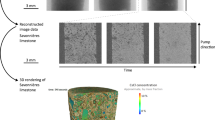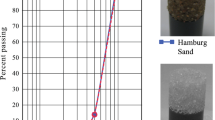Abstract
A new method of measuring local mass transfer for highly complex geometries is demonstrated. The method combines gypsum dissolution and X-ray computed tomography (CT). An object coated in gypsum is CT scanned before and after exposure to fluid flow. Digital three-dimensional pre- and post-flow geometries are created using the CT data, and the local dissolution thickness is determined by subtracting the post-flow from the pre-flow object. The method is first demonstrated for cylinders in cross-flow and validated with mass and heat transfer data. The measurements agree with values from correlations reported in the literature when scaled using Reynolds, Sherwood, and Schmidt numbers. The method is then applied to measure local mass transfer for the complex geometry of a 0.75-scale branching scleractinian coral Stylophera pistillata. Local Sherwood numbers vary between nearly zero on the backward facing surfaces of the downstream branches of the coral and nearly 200 at the tips of the branches at the top of the coral. The upstream facing surfaces at radii between 20 and 70 % of the overall radius of the coral experience Sherwood numbers close to 100. The local measurements are integrated to produce a bulk mass transfer coefficient that lies within the range of previous bulk measurements in the literature for similar coral species. With this method, local mass transfer rates can be measured for complex objects in laboratory or natural in situ flow environments. These are geometries for which only bulk measurements were previously possible.






Similar content being viewed by others
References
Achenbach E (1977) The effect of surface roughness on the heat transfer from a circular cylinder to the cross flow of air. Int J Heat Mass Transf 20(4):359–369
Atkinson M, Bilger R (1992) Effects of water velocity on phosphate uptake in coral communities. Limnol Oceanogr 37(2):273–279
Atkinson M, Falter J, Hearn C (2001) Nutrient dynamics in the Biosphere 2 coral reef mesocosm: water velocity controls NH4 and PO4 uptake. Coral Reefs 20:341–346
Baird M, Atkinson M (1997) Measurement and prediction of mass transfer to experimental coral reef communities. Limno Oceanogr 42(8):1685–1693
Bilger R, Atkinson M (1992) Anomalous mass transfer of phosphate on coral reef flats. Limnol Oceanogr 27(2):261–272
Chang S (2007) Small-scale flow variability inside branched coral colonies: computations and experimental validation. PhD dissertation, Stanford University
Chang S, Elkins C, Eaton J, Monismith S (2009) Flow inside a coral colony measured using magnetic resonance velocimetry. Limnol Oceanogr 54(5):1819–1827
Churchill S, Bernstein M (1977) A correlating equation for forced convection from gases and liquids to a circular cylinder in crossflow. J Heat Transf 99:300–305
Cowen EA (1996) An experimental investigation of the near-surface effects of waves traveling on a turbulent current. Ph.D. dissertation, Stanford University
Culberson C, Latham G, Bates R (1978) Solubilities and activity coefficients of calcium and strontium sulfates in synthetic seawater at 0.5 and 25 °C. J Phys Chem 82(25):2693–2699
Falter J, Atkinson M, Lowe R, Monismith S, Koseff J (2007) Effects of nonlocal turbulence on the mass transfer of dissolved species to reef corals. Limnol Oceanogr 52(1):274–285
Kestin J, Wood RT (1971) The influence of turbulence on mass transfer from cylinders. J Heat Transf 93:321–327
Li Y, Gregory S (1974) Diffusion of ions in sea-water and in deep-sea sediments. Geochim Cosmochim Acta 38(5):703–714
Lowe R, Koseff J, Monismith S (2005) Oscillatory flow through submerged canopies: 2. Canopy mass transfer. J Geophys Res 110:C10017. doi:10.1029/2004JC002789
Mass T, Genin A (2008) Environmental versus intrinsic determination of colony symmetry in the coral Pocillopora verrucosa. Mar Col Prog Ser 369:131–137
Nakamura T, van Woesik R (2001) Water-flow rates and passive diffusion partially explain differential survival of corals during the 1998 bleaching event. Mar Ecol Prog Ser 212:301–304
Pidgeon E (1999) An experimental investigation of breaking wave induced turbulence. PhD dissertation, Stanford University
Porter D, Sanford L, Suttles S (2000) Gypsum dissolution is not a universal integrator of ‘water motion’. Limnol Oceanogr 45:145–158
Reidenbach M, Koseff J, Monismith S, Steinbuck J, Genin A (2006) The effects of waves and morphology on mass transfer within branched reef corals. Limnol Oceanogr 51(2):1134–1141
Sanitjai S, Goldstein R (2001) Effect of free stream turbulence on local mass transfer from a circular cylinder. Int J Heat Mass Transf 44:2863–2875
Sanitjai S, Goldstein R (2004a) Heat transfer from a circular cylinder to mixtures of water and ethylene glycol. Int J Heat Mass Transf 47:4785–4794
Sanitjai S, Goldstein R (2004b) Forced convection heat transfer from a circular cylinder in crossflow to air and liquids. Int J Heat Mass Transf 47:4795–4805
Thompson T, Glenn E (1994) Plaster standards to measure water motion. Limnol Oceanogr 39(7):1768–1779
Van Meel D (1962) A method for the determination of local convective heat transfer from a cylinder placed normal to an air stream. Int J Heat Mass Transf 5(8):715–722
Acknowledgments
The authors would like to acknowledge Ryan Lowe and James Falter for gypsum help and Robert Bennett for CT scanning assistance. This research was supported by NSF grant OCE-0425312.
Author information
Authors and Affiliations
Corresponding author
Rights and permissions
About this article
Cite this article
Chang, S., Elkins, C., Eaton, J.K. et al. Local mass transfer measurements for corals and other complex geometries using gypsum dissolution. Exp Fluids 54, 1563 (2013). https://doi.org/10.1007/s00348-013-1563-x
Received:
Revised:
Accepted:
Published:
DOI: https://doi.org/10.1007/s00348-013-1563-x




